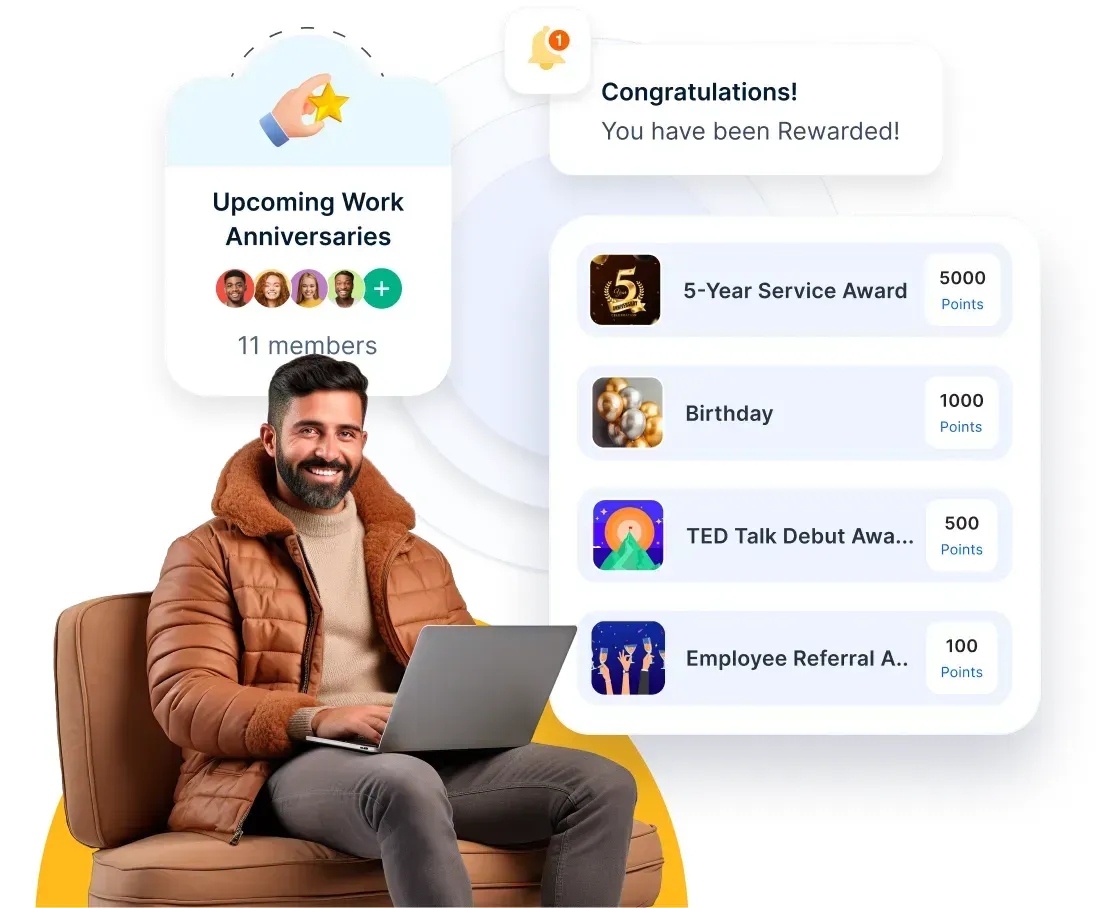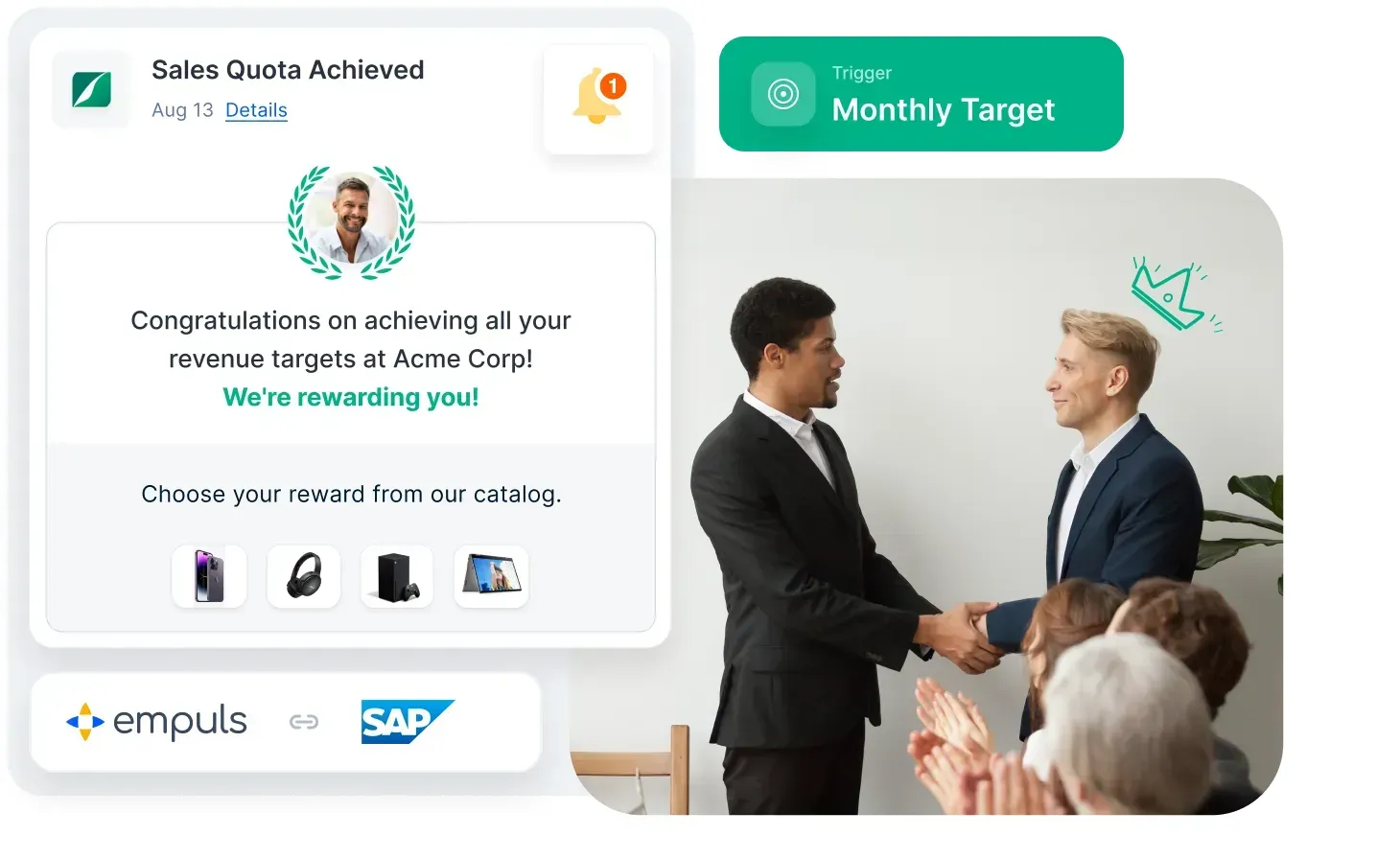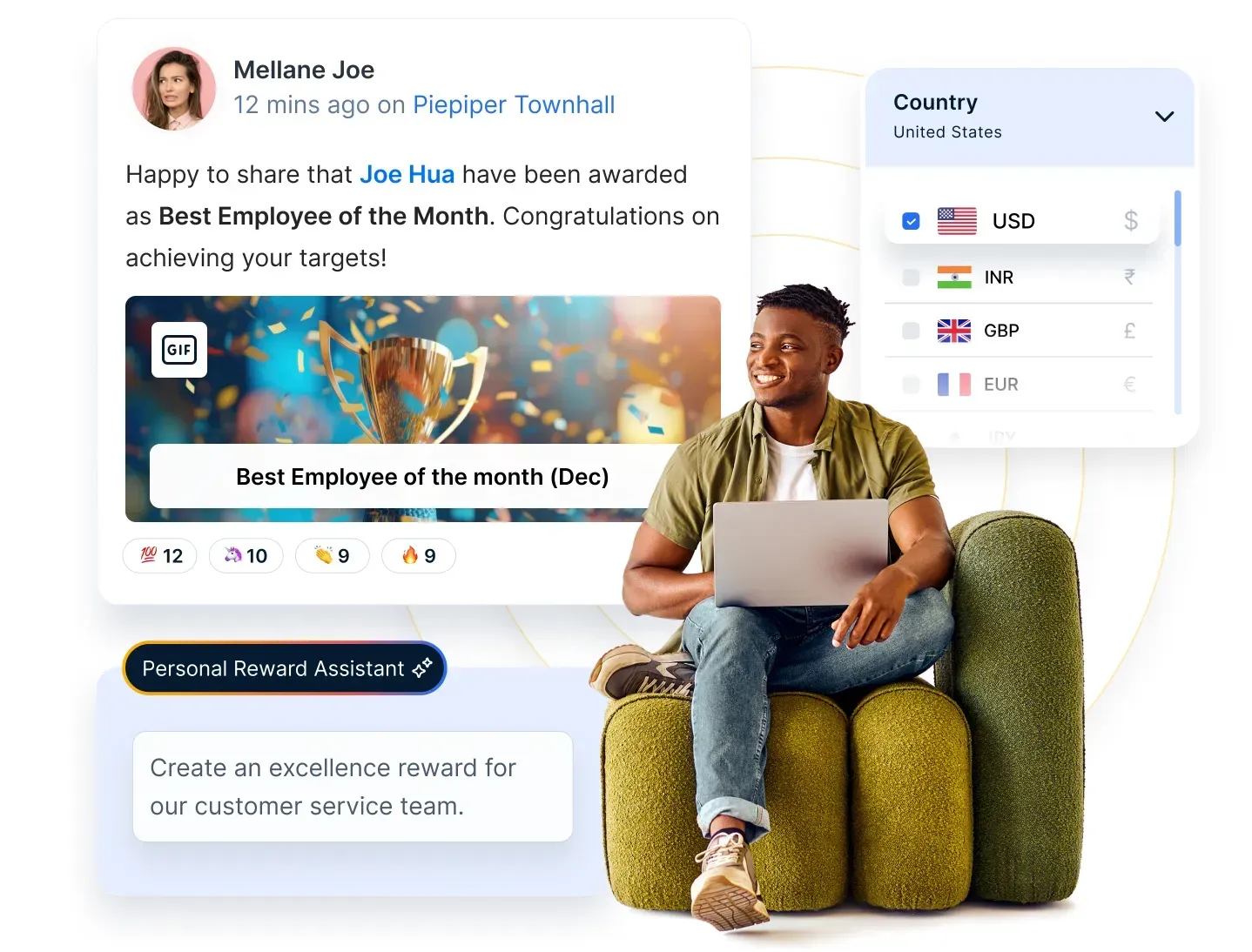On this page
- What is recognition?
- What is gratitude?
- Why is it important to create a culture of recognition and gratitude in the workplace?
- Benefits of building a culture of recognition and gratitude in your workplace
- 10 Ways to create a culture of recogniton and gratitude in the workplace
- How Empuls fuels a culture of recognition and gratitude
Imagine walking into work every day knowing your contributions matter—that your effort isn’t just noticed, but genuinely appreciated. That’s the power of a culture of recognition and appreciation.
And it couldn’t be more relevant today. In a recent survey by McKinsey, 40% of employees reported they were likely to leave their current job in the next 3–6 months, as the Great Resignation shows no signs of slowing down. Employees are no longer just chasing paychecks—they’re seeking purpose, belonging, and to feel valued in their work.
This is where building a culture of gratitude becomes your secret weapon. It’s not about one-off perks or token gestures. It’s about making gratitude and recognition a daily ritual—woven into the way teams collaborate, celebrate, and grow together.
So, how do you create a culture of recognition that doesn’t feel forced or forgotten? One that energizes people, boosts retention, and inspires them to do their best work?
This blog is your blueprint. Let’s explore why recognition and gratitude matter more than ever—and how to make them the heartbeat of your workplace culture.
What is recognition?
Recognition, in general, is acknowledging all the positive things in life, such as the goodness in other people, events, and experiences. Employee recognition acknowledges employees' inherent value, not just their work performance.
Building a culture of recognition involves acknowledging the contribution of employees for their meaningful impact on the bigger picture. Whether it is thanking them for a job well done or recognizing their efforts to help other departments or a member in need, employee recognition encompasses it all.
What is gratitude?
Gratitude, a close sibling of recognition, takes a step further to recognize the influence of outside forces on our success.
The word gratitude is derived from Latin and means 'thankfulness'; therefore, it can also be thought of as a 'thankful recognition.' Gratitude in the workplace is the foundation of trust, empathy, and communication, all of which are the most sought-after attributes of a strong organizational culture.
Why is it important to create a culture of recognition and gratitude in the workplace?
Human beings are social animals, and relationships are fundamental to any group structure–be it a family, a group of friends, or colleagues. Unfortunately, in the middle of hectic work cycles, employees get little time to bond to the team and organization in productive ways.
A culture of recognition and gratitude fills in the gaps by engaging employees in thank-you activities that build trust while making them feel valued. At an organizational level, a culture of recognition and gratitude is closely tied to productivity, engagement, and employee retention.
Benefits of building a culture of recognition and gratitude in your workplace
Building a culture of recognition goes beyond handing out praise—it's about creating a workplace where people feel seen, valued, and motivated to do their best. Here are a few key benefits that come with making recognition part of your everyday work culture.
1. It can boost employee morale and job satisfaction
When the employees of an organization are appreciative of one another, it has the effect of lifting employee morale. It motivates them to work as a team and improves job satisfaction on the whole.
2. It reduces stress and absenteeism
A culture of gratitude makes the employees feel valued, reducing job insecurity and the stress associated with it. The lowered tension in the work environment also reduces sick leaves and encourages people to show up to their work.
3. It boosts employee productivity
Employees who are regularly appreciated by their managers and peers are more confident and engaged in their work. Such happy employees are eager to perform better and maintain their role as valued employees.
4. It increases employee retention
Productive and engaged employees with the strong work culture of gratitude are satisfied with their job. Moreover, having such stability and nurturing atmosphere at work can significantly reduce employee turnover.
5. It helps attract talent
A strong work culture turns employees into ambassadors for the organization helping the recruitment efforts. In addition, word of mouth of happy employees improves the employer's value proposition and entices top talent.
10 Ways to create a culture of recogniton and gratitude in the workplace
The key to unlocking higher levels of engagement, happiness, and productivity in the workplace lies in creating a culture of appreciation and gratitude. So, here are some important tips on how to build a culture of appreciation and gratitude at work:
1. Promptly send thank you notes and emails
Whether for closing a deal, securing new business, achieving goals, or generating new ideas, make it a habit to send thank you notes and emails. Being prompt with your appreciation shows your employees that you are grateful for their efforts and value their presence in the workforce. To make it highly effective, send out the email immediately after an event or write a hand-written note to make it extra memorable.

Automate thank-yous and milestone celebrations with ease
Why wait to say thanks? Empuls makes it easy to send automated appreciation messages and gifts for birthdays, work anniversaries, project completions, and more. With built-in workflows and smart nudges, you can ensure that no moment of recognition slips through the cracks.
Learn More
2. Personalize your approach to the appreciation
Appreciation is most effective when it is delivered in a highly personalized manner. While personalization by itself has a strong impact, appreciating employees in a way in which they like to be appreciated can make all the difference.
For example, while some are elated by a simple thank you note, others might expect a tangible gift or public recognition for their success. The way to figure out their appreciation language is to observe how they appreciate others. Managers and team leaders will have personalized insights into their team members that can determine the best way to appreciate each individual.
3. Celebrate both the big and small victories
Celebrating big wins is necessary to break up the monotony of long project durations and return the employees with increased passion, dive, and focus. Big celebrations are also a time for employers to get creative with their rewards. Small wins also deserve celebrations as they build the path towards big wins.
The secret to maintaining morale is to break up the task into bite-sized chunks with a frequent appreciation for every little victory. Small and frequent pats on the back are what keep the employees on their toes to stay productive.

Celebrate wins—big and small—with visibility
Empuls’ company-wide social feed turns individual accomplishments into collective celebrations. From shoutouts to wishboards, every win can be broadcast to boost morale and motivate others to follow suit.
4. Incorporate gratitude into leadership
Leaders in an organization’s management are responsible for guiding individuals and teams towards organizational goals. However, with the stress and anxiety of being reactive to the dynamic business landscape, leaders seldom have time to appreciate their teams.
The condition is further exacerbated by the lack of trust many employees have in the management. Leaders can strengthen employee morale and trust by holding gratitude debriefing sessions after project completion and actively appreciating everyone for their contribution periodically.
Since implementing this personalized approach, we've observed a 35% increase in employee engagement and a 25% decrease in turnover rates. This strategy has also positively impacted our customer relations, with a 20% boost in repeat customer interactions. These figures underscore the significance of a leadership style that's not just about guiding, but genuinely appreciating each individual's contribution to our collective success.
5. Make gratitude part of your storytelling
Your social media posts, blog content, podcasts, vlogs, and newsletters form the narrative about your organization. Weaving gratitude into your stories is a component of building a culture of employee appreciation. Include stories that talk about the contribution of your employees to your success in a tone that is highly appreciative and grateful. Talk about gratitude as part of the organization’s culture from the top down and across.
6. Create opportunities to express gratitude
To build a culture of gratitude, everybody needs a chance to participate. The change can come in the form of informal meetings every month or every week where everyone takes a turn to express their gratitude to individuals or the whole team.
Other exercises can include writing a gratitude journal, leaving anonymous gratitude notes on a notice board, or gratitude box entries for something good that happened at home or work. Employee rewards and recognition programs established by organizations are also a great way to reinforce a culture of appreciation.
7. Highlight the best qualities of individuals
Building a culture of employee appreciation is incomplete unless the individual is highlighted. Appreciating the best qualities of individual employees is one of, if not the most powerful way to bring out the best in the person.
Appreciate seldom recognized qualities such as honesty, admitting to mistakes, and willingness to learn and change. An exercise in the same direction could be to give turns to each employee to sit in the ‘appreciation hot seat’ while their team members go around talking about their best qualities.
8. Thank those who are seldom appreciated
All organizations have employees who are seldom or rarely recognized for their work which keeps the organizational machinery running smoothly. These include people working in support roles such as IT, HR, accounting, maintenance, and janitorial staff.
Thanking them periodically is central to building a culture of appreciation as it highlights the interdependence of different departments in an organization. Be authentic in appreciating the unsung heroes, and you will boost the morale of everyone in the organization.
9. Promote peer-to-peer appreciation
Although appreciation by the managers and leaders is significant, peer-to-peer appreciation has a more profound impact. Employees in every team share a sense of comradery and the highest honor one can receive is to be recognized and thanked as an important team member. Establishing peer-to-peer recognition programs can solidify your efforts toward building a culture of appreciation and gratitude.
Empuls empowers everyone to participate in creating a culture of gratitude through peer-to-peer recognition tools. Employees can give kudos, send hi-fives, and nominate peers for awards—strengthening camaraderie and trust across teams.
10. Build a culture of appreciation in the workplace
Employee recognition is central to creating a culture of appreciation at the workplace. Recognition of employees involves recognizing not only the outcomes but also the efforts and the progress.
Public recognition in the form of company-wide shoutouts boosts the morale and self-esteem of employees. Recognition can take the form of congratulating on completing projects, reaching milestones, or even a simple “thank you.”
How Empuls fuels a culture of recognition and gratitude
Want to make recognition second nature at your workplace? That’s where Empuls steps in.
Empuls isn’t just another HR tool—it’s your all-in-one sidekick for sparking joy, boosting morale, and creating those "you matter" moments across the organization. It makes recognizing and rewarding your team as easy (and fun) as sending a GIF.

Here’s how Empuls helps you build a culture where gratitude flows and recognition shines:
- Recognize in real time With smart nudges and seamless workflows, Empuls makes it easy to appreciate someone the moment they go above and beyond—no more “I’ll thank them later” moments.
- Make every milestone magical: Birthdays, work anniversaries, service milestones—you name it, Empuls celebrates it. From automated wishes to curated rewards, it's all taken care of.
- Peer-powered positivity: Give everyone a voice. Empuls enables peer-to-peer shoutouts, hi-fives, and appreciation badges, turning teammates into cheerleaders.
- Recognition that’s actually rewarding: Choose from a global catalog of gift cards, experiences, wellness perks, charity options, and more. Recognition becomes personal, memorable, and meaningful.
- Let AI do the heavy lifting: Em, the AI assistant, helps managers spot recognition gaps so that no one feels left out. It’s like having a gratitude compass built right into your culture.
Put recognition in the spotlight: From townhalls to social feeds, Empuls turns recognition into a shared celebration. Everyone sees it, feels it, and wants to be a part of it.
Book a demo with Empuls today and start turning everyday moments into reasons to celebrate.
Closing thoughts
As social animals, we are wired for acceptance, recognition, and gratitude from our peers. To establish a culture of gratitude, it is essential to start from the top-level management and let it trickle down to teams and individuals.
A culture of recognition takes time to establish, but once embedded, it builds trust, strengthens teams, and fosters lasting engagement. Over time, people begin to believe in it—and that’s when it becomes a true culture, not just a practice.


















